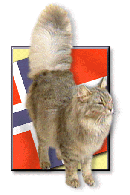BREED: Norwegian Forest Cat
TEMPERAMENT: Active, affectionate
LIFESPAN: 12-16 years
RECOMMENDED FOR: Active people
Appearance: Norwegian Forest Cats are very large cats, with neutered males reaching 10kg (22lb) and toms and females slightly smaller. The extremely thick coat and neck ruff enhances the massive appearance. Coat patterns include tabbies, bicolours and solids, in all their colour variations. The cats have a spectacular plumed tail and the hind legs are longer than the front. They take two to three years to mature physically.
Temperament: Owners say they are affectionate but not a ‘lap cat’, and have an active, independent nature. They are intelligent, and do not always like being confined inside.
Health:
Generally a healthy strong breed.
Progressive retinal atrophy (PRA) is known in the United States.
Grooming: The thick, non-matting coat, which copes with the harsh northern winters isn’t as well-suited to Australian conditions and will need to be brushed thoroughly each week. At the end of winter it sheds in vast amounts and daily grooming may be needed at that time. Some books suggest that shampooing the cat can be difficult as the outer coat is water resistant.
Breeding: Most books suggest the cats breed easily with six to eight kittens per litter. Being a new import, Australia has yet to produce a litter. One English breeder reported some have needed caesareans.
Housepet potential, space & exercise: Norwegian Forest Cats are said to be agile climbers and quite muscular. Their strong hunting instinct should discourage owners from allowing their cats outdoors. A scratching post is recommended. The long coat will lose hair, peaking in spring as the heavy winter coat is shed.
Ideal owner: Australian owners believe their cats will suit active people who would enjoy a large, relatively active cat. One owner has trained her Norwegian Forest Cat to accept and walk on a harness. UK breeders say the cats don’t like being left alone for long periods.
Popularity: There are only a handful of Norwegian Forest Cats in Australia, and more are being imported. Even in their country of origin, Norway, there are only about 1200 registered.
History: While Norway has a rich history of cat legends, the Norwegian Forest Cat was a farmyard animal for many years before its type was described and accepted for pedigree status in 1912. A club was formed in 1938 but World War II intervened and it wasn’t until the 1970s that it was again promoted and accepted internationally. Still relatively rare outside Scandinavia.
Further information
We filmed our segment with:
Kerry Evans
51 Dorrigo Road
Armadale, WA, 6112
Phone: (08) 9497 4502
Mobile: 0413 281 334
Email: [email protected]
QLD
Queensland Feline Association Inc.
Sec: Jenny Weekes
PO Box 1578
Mudgeeraba
QLD 4213
phone: (04) 3395 1013
email: [email protected]
SA
Judith Adams, breeder
Phone: (08) 8276 1723
TAS
Cat Control Council of Tasmania
Secretary Dr. John Grove
650 Blessington Road
White Hills
TAS 7258
email: [email protected]
VIC
Loraine Smith, breeder
Phone: (03) 59 985506
NSW
Sandra Dukes, breeder
Phone (02) 4443 3622
WA
Greg and Liz Hogan, breeders
Phone: (08) 9439 3738
Cat Association of the Northern Territory
Mrs Heather Havens
PO Box 3870
Darwin, NT, 0801
Phone: (08) 8932 5225
Email: [email protected]



